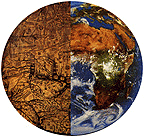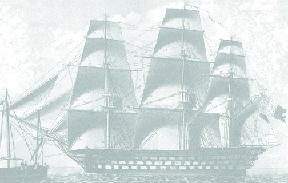
Act II, Scene 1: Sayonara Diorama

Act II, Scene 1: Sayonara Diorama
Synopsis: The Beagle Sequel
Setting the Scene..........
Thirty years after the first Voyage of the Beagle, Charles Darwin and Captain Fitzroy set out again in order to document the changes which had occurred in the time between the two voyages.

They did this in order to create maps in the service of a Universal Gentlemen's Agreement: A Guide to A Hand's-Off Policy for Circumventing the Erosion and Exploitation of Natural Resources in the World which they planned to introduce into their culture upon their return.
IN spite of their great experience in the world, both of them remained certain that such a map would be used for the sole purpose for which it was intended.While at sea Darwin and Fitzroy share their intense positions on organized religion. The resonance of their theological simmer rolls over into a quarrel which triggers a tremendous storm.
Simultaneously, on a yet unchartered island in the same open sea, Fate is forcing its way through a fissure in the earth's core up to the underbelly of a volcano. Appalled at the lateness of the hour for a visit, the volcano blows its stack. Fate, exp elled from the volcano's throat, rises up from the earth and couches itself like a recalcitrant buddha on the crest of spewing lava. The crest collides with the fierce gusts of Darwin and Fitzroy's altercation.
Sailors struggle to steer clear of the resulting vortex; but in the end Fate has the upper hand in its unequivocal ability to sit completely still as a sublime form of resistance. The Beagle is shipwrecked and all hands disappear. Captain Fitzroy is disp atched to a well-known island on the charts called Heaven.Darwin finds himself washed ashore on a yet unchartered, strange, dark island inhabitated by, at first glance, inexplicable creatures.
The play begins....
Marooned on the island, Darwin begins to study its life. He concludes there are three active species on the island:
Species, in order of appearance:
A species of insects, much like horseshoe crabs, seemingly made from mechanical debris or what we would call space junk. These creatures can see and some can speak but for the use of these senses they are completely dependent upon the kindness of strang ers. For, having no hands of their own, they cannot move without their antennae in the hands of another creature directing them. They even refer, in their language, to their empowering antennae as Joyce_ticks.
A species of fantastical characters. The lovely Pandora, daughter of Prometheus. She is more luscious to Darwin than the flora of Terra del Fuego, more wise and loving than the women of his own family. He loves and fears her passion in giving herself totally to her faith in imagination. He studies her treasures, the blessings, the demonaic evils and spirits..
During the course of his visit he begins to feel a great empathy for her in that he himself is viewed in his world as having also opened a Pandora's box. His own work has brought his faith in organized religion into question. He fears he may have become a mechanical thing, more mechanical than the robot/insects, observing and analyzing but never HOLDING anything in his arms, never embracing imagination.She is in company with the manifestations of the Mappa Mundi monsters birthed in the 3rd century by Solinus, a popular writer and cartographer:
Mr. Blemye Mr. PanottiDarwin sets up his laboratory and commences with a study of the place and its inhabitants. Since some of the creatures speak English, Darwin is soon engaged in conversational exchange with them.
and Mr. Sciapod
Troubling issues emerge. Darwin defends cartographers who marginalize all unknown creatures by making them monsters and designating them to the edge of the world by saying they have to do the best they can to chart the world.
There is debate followed by a second big thunderstorm and volcanic eruption. The third species is revealed, a series of formerly dormant windup monsters, who exist in memory only, but use quite a bit of it.
Each species fears that one of the "other" species represents the future.
In the end Darwin learns that his democratic love for all creatures equally is not a bad thing, and also, that he is entitled to love some more personally than others. (e.g., Pandora).
All of the creatures gain an understanding that their instinct has indicated long ago, that "process" is what matters, not product.
-fini- The name of this piece "Sayonara Diorama" conveys a goodbye to the glorification of that still moment that is romanticized out of proportion in contrast to all of the other moments. Darwiin understands that the process of his long years of research and p ublishing were more meaningful for him personally than the inevitable publication of his theoretical work which rocked the world. Darwin confirms that his own hesitation in publishing his theory was an understandable thing, not just out of faintheartedn ess but out of fear of disruption of the process of his work.